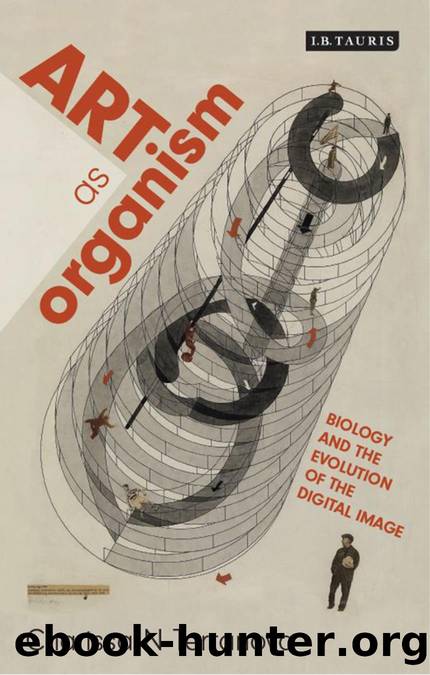Art As Organism by Terranova Charissa N.;

Author:Terranova, Charissa N.;
Language: eng
Format: epub
ISBN: 9780857728944
Publisher: Bloomsbury UK
Published: 2019-11-22T00:00:00+00:00
IV.Wetware between Cognitive and Non-Cognitive Mapping
Lynch intended his theory of the urban image to create an order similar to the orientation provided by classical cartography, even as its wet, mobilized, and shape-shifting qualities ran counter to the conventional “map.” Prima facie these two traditions of space-making—cartography and the environmental image of Kepes and Lynch’s early research project and Lynch’s later books—seem at odds, one being inert, rather timeless, a means to understand the world while also exploiting power, and the other dynamic, deliquescent, and a tool to grasp a sense of place while also subverting extant power structures within modern planning. Lynch struck out into remote territory, combining the traditional map with cognitive science in the creation of the biologically distributed image of the city, formulating a new kind of cartography in the form of “cognitive mapping.” Yet Lynch did not recognize the “image of the city” as “cognitive mapping” until thirteen years later, and it was only implicit then.112 Lynch’s essay on cognitive mapping, “Some References to Orientation,” was part of the 1973 anthology Image and Environment: Cognitive Mapping and Spatial Behavior, co-edited by Roger M. Downs and David Stea. Collectively, the book is a combination of environmental geography, psychology, architecture, and urban planning. Downs and Stea, professors of geography and architecture and urban planning respectively, chose economist-cum-philosopher and GST expert Kenneth E. Boulding to write the foreword. There, Boulding describes the group of contributors as an “invisible college,” staking out the territory of a new discipline that focuses on a “theory of scientific epistemology.”113 Connecting the anthology back in time to the greater research project of Kepes and Lynch, Boulding relished the fact that his 1956 book The Image figured so prominently in the history of cognitive mapping. Cognitive science and Gestalt psychology figure centrally in the essay included in the anthology by Donald Appleyard, professor of urban planning and design at UC Berkeley and Lynch’s collaborator in The View from the Road. Using language reminiscent of the Perceptual Form of the City in his essay, Appleyard argues not simply for patience with cognitive representations of the city that are “incremental and disjointed,” but for recognition of their importance, contending that the “structure of urban knowledge… is difficult to grasp and full of seemingly contradictory qualities.”114 Taking a related tack, Lynch defines “cognitive mapping” in terms of General Systems Theory in the essay “Some References to Orientation,” explaining to his readers that an understanding of the “environmental image” is distributed across fields. Rather than being a matter of expertise in a single field, logic of the image as distributed or ecological is best gleaned “from ancient and modern literature, books on travel or exploration… newspaper accounts [and] psychological and anthropological studies.”115 In this later development of the cognitive and spatial image, Lynch notably qualifies his idea with the word “environmental,” thereby bestowing it with a logic that is at once systems-based and organic. While lost to the ages, he believes, the distributed environmental image is irrefutable, a part of our biology, and still “a fundamental part of our equipment for living.
Download
This site does not store any files on its server. We only index and link to content provided by other sites. Please contact the content providers to delete copyright contents if any and email us, we'll remove relevant links or contents immediately.
The Secret History by Donna Tartt(18157)
Red Sparrow by Jason Matthews(5195)
Harry Potter 02 & The Chamber Of Secrets (Illustrated) by J.K. Rowling(3555)
In a Sunburned Country by Bill Bryson(3364)
Drawing Cutting Edge Anatomy by Christopher Hart(3290)
Figure Drawing for Artists by Steve Huston(3267)
Harry Potter and the Prisoner of Azkaban (Book 3) by J. K. Rowling(3108)
The Daily Stoic by Holiday Ryan & Hanselman Stephen(3107)
Japanese Design by Patricia J. Graham(2997)
The Roots of Romanticism (Second Edition) by Berlin Isaiah Hardy Henry Gray John(2819)
Make Comics Like the Pros by Greg Pak(2757)
Stacked Decks by The Rotenberg Collection(2685)
Harry Potter and the Deathly Hallows (7) by J.K. Rowling(2549)
Draw-A-Saurus by James Silvani(2501)
Tattoo Art by Doralba Picerno(2484)
On Photography by Susan Sontag(2481)
Foreign Devils on the Silk Road: The Search for the Lost Treasures of Central Asia by Peter Hopkirk(2385)
Churchill by Paul Johnson(2360)
The Daily Stoic by Ryan Holiday & Stephen Hanselman(2341)
